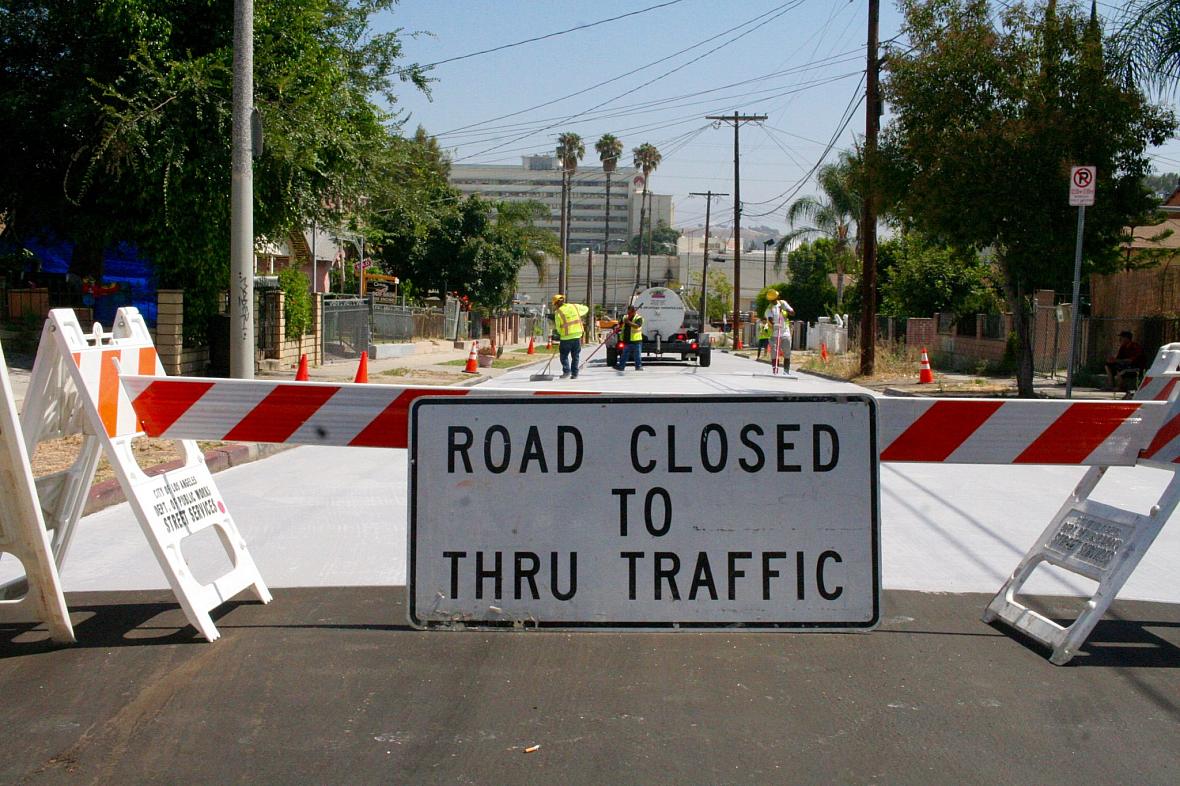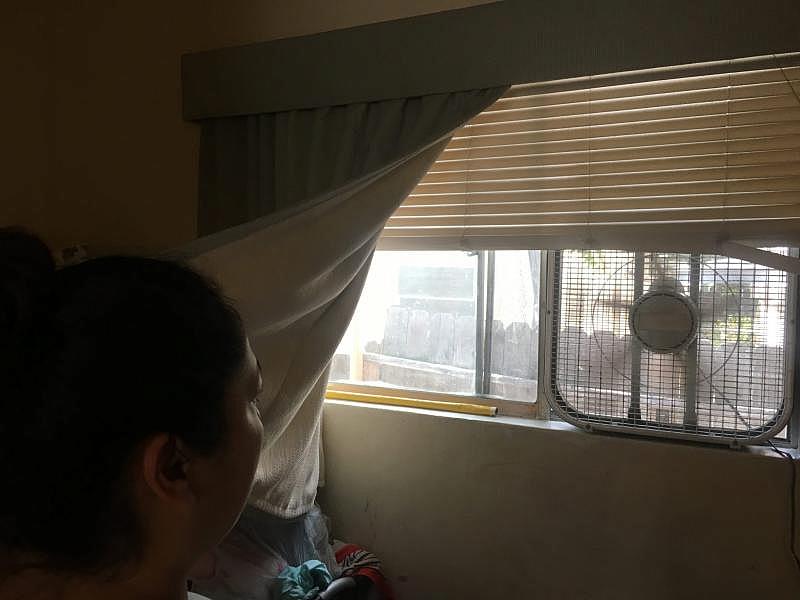What you need to know about LA’s urban heat problem
This story was made possible with support from the Center for Health Journalism at The University of Southern California.
Other stories in the series include:
The danger of urban ‘heat islands’
How Hot Was It In California Homes Last Summer? Really Hot. Here's the Data
Investigation Finds Home Can Be the Most Dangerous Place in a Heat Wave
Extreme Heat Killed 14 People in the Bay Area Last Year. 11 Takeaways From Our Investigation
Even in San Francisco, Heat Is Turning Deadly. That's Not Something Colleen Loughman Expected.
It's getting (dangerously) hot in Herre
Being outside can be dangerous, especially at school
Sweltering in nursing home, 95-year-old succumbs to heat, as climate endangers most vulnerable
New Rule Would Require Employers to Protect Indoor Workers From Heat Illness

Behind a barrier on Lord Street east of downtown, Los Angeles city workers spread “cool pavement” material that, once dried, immediately cools the ground 15-20 degrees. (Photo: Molly Peterson)
LA can get hot. Really hot.
Some of the heat comes from the landscape itself: the “urban heat island” effect renders this concrete jungle almost six degrees hotter than the surrounding desert. Some of the heat comes from climate change: the number of extreme heat days in Southern California is on the rise, according to UCLA. Some of the heat comes from the way we live, because the temperature varies around you: whether you’re indoors or out, at school and home, under a tree or on a sidewalk, with central air or a cheap box fan.
All together, this city heat is a growing public health threat. Heat kills 60 to 70 Angelenos every summer, according to University of Miami climatologist Larry Kalkstein. But even though heat causes more deaths and medical problems than most other natural disasters, it’s rarely identified as the culprit.
So here are eight things you need to know about the effects of heat, and how to cool down your house, street, neighborhood, and city.
No one is really measuring the problem
Public health agencies and doctors undercount the health impacts of heat, and they know it. “Doctors don’t even think of exposure to heat as a real problem sometimes,” says UCLA professor of medicine and public health David Eisenman. “It’s not been a statewide effort to help the medical profession understand this better. We’re not doing anything to help make sure this gets diagnosed more often. We’re not doing anything to systematically warn our patients about it. So this is not being dealt with on a professional level in California.”
LA is trying to cool things down
In Los Angeles, the city is targeting the “urban heat island” effect specifically. The city’s goals are to cool itself by 1.7 degrees by the year 2025, and 3 degrees by 2035. Here’s how:
Make an urban canopy: With its CityPlants nonprofit, LA plans to spend $4.8 million planting 40,000 trees in the next two years. (The region has 10 million trees already; a study has found that there’s room for 1 million more.)
Cool down pavement: LA is spreading a special lighter-colored material over one city street in each of 15 council districts. It’s a demo phase: cool pavement is still more expensive than the usual asphalt, and it doesn’t yet meet material safety standards for wider, busier streets. In the near term, according to the LA Bureau of Street Services’ Greg Spotts, LA’s trying to be an influencer. “We want to stimulate other cities and all kind of product manufacturers to experiment,” he says.
Cool roofs: LA became the first U.S. city to require heat-reflecting roofs for new or significantly remodeled housing after a USC study led by George Ban-Weiss found that would cool the city significantly. Twelve thousand new cool roofs have been added so far.
“It’s not perfect and it’s not immediate,” says Lauren Faber O’Connor, LA’s Chief of Sustainability. “Certainly we always have a desire to go faster,” she says. “Always. But there’s a lot of things that we can be doing at once. And that’s what we’re trying to do, is march on all fronts.” She says she’s glad the city isn’t alone: the county’s working on a heat strategy too.
Urban heat isn't equal across LA
North Hollywood renter Amy Gonzalez says heat causes health problems for her family. She says air conditioning is too expensive; even strategically using fans costs a hundred dollars a month for a 3-room apartment. The Coalition for Economic Survival has helped Gonzalez in her dispute with her landlord, but nothing gives her a right to AC. (Photo: Molly Peterson)
Winds blowing over the city from the Pacific complicate the urban heat island effect, especially on the west side, says USC environmental engineer George Ban-Weiss. Even accounting for it, he says, “what you end up seeing is that there are some regional hotspots and cool spots.” Risk from heat isn’t equal either. UC Berkeley environmental scientist Rachel Morello-Frosch found in a national study that, “in general, people of color…in urban areas are more likely to live in high heat island risk neighborhoods compared to their white counterparts.”
At UCLA, a team led by professor of medicine David Eisenman has gathered data about emergency room visits for the first time to map which Los Angeles County neighborhoods have the highest risk of heat-related illnesses during heat waves or even just on one hot day. Maybe it’s not surprising that risks are higher in Pacoima and the San Fernando Valley, Palmdale, Lancaster, and east Los Angeles County. But in places like Norwalk and South L.A., more ER visits may raise questions about where city officials should concentrate communication efforts, which neighborhoods need cooling centers, and what makes health problems worse for Angelenos.
Air conditioning is not a right
According to the CDC, A/C is the best defense against heat illness; fans don’t do much good when temperatures soar into the 90s. Even Angelenos who have A/C may not use it because electric bills can be too high. And, under state law, landlords generally only have to provide heat and running water. Low-income housing advocates in LA say heat is becoming a more common problem for tenants. To fight heat inside your home, you may be able to:
Upgrade your A/C through an energy efficiency program. LADWP offers a $50 credit on replacing your window or portable air conditioning with a newer model, and sometimes offers money for upgrading central air conditioning systems .
Get your bills covered. Under the Home Energy Assistance Program funded by federal block grants, the Maravilla Foundation may pay one utility bill a year for you in the San Fernando Valley. In Westside L.A. and communities like Compton, Inglewood, El Segundo, Hawthorne and Hermosa Beach, PACE/HEAPdoes the same thing.
Seek discounts on electricity bills from your utility. LADWP offers discounts for seniors, disabled people, and low-income residents that can be combined.
Seek legal help. Advocates say landlords may be obligated to accommodate A/C requests, or repair A/C they previously installed.
“Affordability is a huge priority,” says LA’s Sustainability Chief, Lauren Faber O’Connor. “We would never want someone to feel they have to choose between, you know, can they afford to turn on their A/C or do they need to sit in a boiling hot home.”
However, in some cities, officials think A/C should be required by law. In Sacramento, California state assemblyman Roger Dickinson floated the idea four years ago. Last year, a city councillor in Toronto proposed a ceiling for heat for his city, where people in high-rises mostly don’t have air conditioning now; regional health authorities shot the idea down. And New York considered a maximum allowable temperature in “residential facilities and supportive housing for vulnerable populations.” Officials there decided it needs more study.
If it's really hot, you should check on your neighbors

